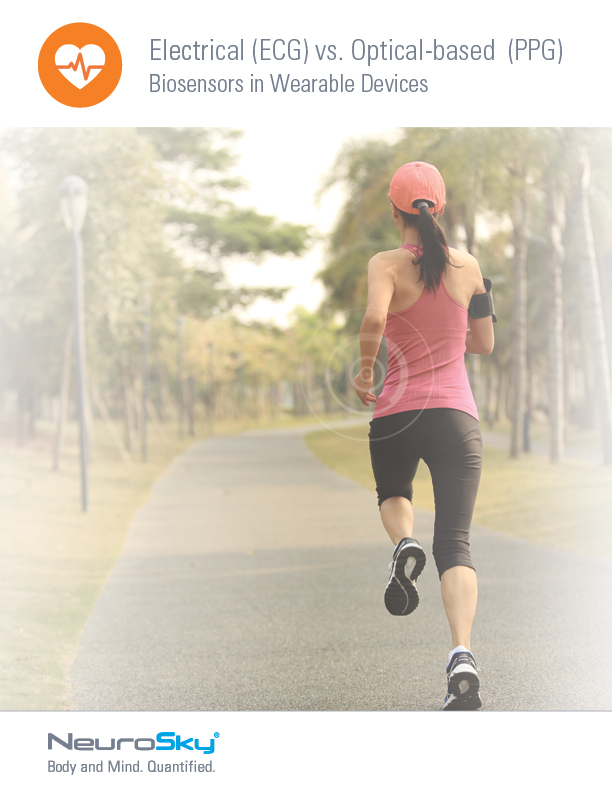Recent technological advances have made it possible to build wearable products that can capture and process bio-signals generated by the human body. When it comes to heart rate monitoring, two primary technologies are available to device manufacturers: ECG and PPG.
If you’re deciding whether ECG or PPG could help you create the next big wearable device, to help you assess which technology is best for your application, this post defines each type of sensor and offers an overview of their respective capabilities.
ECG & PPG Sensors Defined
- ECG (electrocardiography) sensors measure the bio-potential generated by electrical signals that control the expansion and contraction of heart chambers.
- PPG (photoplethysmography) sensors use a light-based technology to sense the rate of blood flow as controlled by the heart’s pumping action.
Comparison Questions: ECG vs PPG Sensors
- How is heart activity measured?
ECG sensors directly use electrical signals produced by heart activity. PPG uses electrical signals derived from light reflected due to changes in blood flow during heart activity - Which is most accurate?
ECG is a reference standard signal that is used for monitoring cardio health and wellness by healthcare providers . PPG sensors on the other hand typically use ECG signals as a reference for static HR (Heart Rate) comparison. - Can Heart Rate (HR) be measured?
With ECG, HR can be measured accurately. HR can be measured with PPG, however it is only suitable for average or moving average measurements. - Can Heart Rate Variability (HRV) be measured?
HRV can be reliably derived from ECG data as R-Peak Intervals can be extracted with millisecond accuracy, so that meaningful HRV data can be obtained with short-duration measurements. With PPG sensors, Peak Interval accuracy is limited by usable sampling rate due to the high power consumption of LEDs. With PPG, Pulse Rate Variation correlates with HRV for longer periods of measurement (> 5 minutes), but not for short-duration measurement. - How long does it take to take a reading?
ECG sensors don’t require long settling times, so meaningful readings can be obtained very shortly after start-up. PPG sensors require a relatively long settling time due to the need for measuring the amount of ambient light and calculating the compensation needed for cancelling its effect. PPG sensors may also require compensation of motion artifacts to produce a reading. - Which has the lowest power consumption?
NeuroSky’s BMD101 ECG sensor features extremely low power consumption, operating at 2.5mW. Most PPG sensors require approximately 30mW of operating power. - Which has the smallest footprint?
The BMD101 ECG is the world’s smallest ECG sensor at only 3mmx3mm, with no additional components required. PPG sensors feature a relatively large PCB footprint package—typically 6mmx6mm—plus additional PCB area for a microcontroller unit (MCU), battery management, crystal, and LED circuits. - Is any external equipment required to produce a reading?
The BMD101 ECG sensor features on-chip HR measurement, so no external equipment is required. In contrast, the PPG sensor requires external microcontroller unit for HR calculation. - How easy is it to integrate with a device?
The BMD101 ECG sensor features an SDK (Android/iOS) for easy app development and integration. PPG sensors require MCU firmware development and integration in addition to host platform app development and integration
When it comes to key considerations like size, power consumption, accuracy, ease of integration and richness of data, ECG biosensors present a clear advantage over their PPG counterparts for heart rate monitoring.
ECG biosensors are capable of delivering the widest range of heart health metrics because they are able to capture more comprehensive signals of overall heart performance, including both Heart Rate (HR) and Heart Rate Variability (HRV).
In contrast, PPG sensors are capable only of measuring HR, and less reliably than with ECG biosensors. The key challenges with PPG technology are cancelling the effects of ambient light, accommodating different skin conditions and colors, and dealing with physical motion artifacts. Additionally, PPG can only be used on parts of the body that have a high concentration of blood vessels (for example, it can be difficult to get a good PPG signal from the wrist).
To learn more about how ECG and PPG sensors compare for heart rate monitoring, download the free Comparison Chart: Electrical (ECG) vs. Light-based (PPG)Biosensors in Wearable Devices now.



